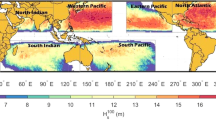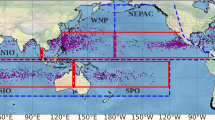Abstract
In this discussion, the authors will demonstrate that the large discrepancy of results in Kumar et al. (Nat Hazards 1–19, 2022) using different fitting methods is a cause of inappropriate implementation of some methods. The authors will also show the significant overestimate of the higher return period wind speeds using the basin-wide maximum sustained wind speeds compared to the results using simulations.




Similar content being viewed by others
References
Cook NJ (1985) The designer’s guide to wind loading of building structures part 1. Butterworths, London
Cook NJ, Harris RI (2004) Exact and general FT1 penultimate distributions of extreme wind speeds drawn from tail-equivalent Weibull parents. Struct Saf 26(4):391–420
Harper BA, Mason B (2016) A tropical cyclone wind event data set for Australia. 18th Australasian Wind Engineering Society Workshop. McLaren Vale, South Australia, pp. 6–8. July, 2016.
Harris RI (2009) XIMIS, a penultimate extreme value method suitable for all types of wind climate. J Wind Eng Ind Aerod 97(5–6):271–286
Hong HP, Li SH (2013) Discussion on “plotting positions for fitting distributions and extreme value analysis.” Can J Civ Eng 40(10):1019–1021
Hong HP, Li SH (2014) Plotting positions and approximating first two moments of order statistics for Gumbel distribution: estimating quantiles of wind speed. Wind Struct 19(4):371–387
Hong HP, Li SH, Mara TG (2013) Performance of the generalized least-squares method for the Gumbel distribution and its application to annual maximum wind speeds. J Wind Eng Ind Aerodyn 119:121–132
Hong HP, Ye W, Li SH (2016) Sample size effect on the reliability and calibration of design wind load. Struct Infrastruct Eng 12(6):752–764
Knapp Kenneth R, Diamond Howard J, Kossin James P; Kruk Michael C, Schreck Carl J. III (2018) International best track archive for climate stewardship (IBTrACS) Project, Version 4. NOAA National Centers for Environmental Information. https://doi.org/10.25921/82ty-9e16
Kumar DS, Behera MR, Nadella S, Kumar AV (2022) Probable maximum tropical cyclone parameters for east and west coast of India. Nat Hazards, 1–19
Li SH (2018) Effect of disjunct sampling on calibration of design wind speed. J Wind Eng Ind Aerod 183:283–294
Li SH (2023) Effect of nonstationary extreme wind speeds and ground snow loads on the structural reliability in a future Canadian changing climate. Struct Saf 101:102296
Li SH, Hong HP (2015) Use of historical best track data to estimate typhoon wind hazard at selected sites in China. Nat Hazards 76:1395–1414
Li SH, Hong HP (2016) Typhoon wind hazard estimation for China using an empirical track model. Nat Hazards 82(2):1009–1029
Li SH, Suresh Kumar K (2021) Cyclone wind hazard assessments for eastern coastal cities in India using a fast-predictive model. J Wind Eng Ind Aerodyn 218:104760
Li SH, Irwin P, Lounis Z, Attar A, Dale J, Gibbons M, Beaulieu S (2022) Effects of nonstationarity of extreme wind speeds and ground snow loads in a future Canadian changing climate. Nat Hazard Rev 23(4):04022022
Li SH, Hong HP (2014) Observations on a hurricane wind hazard model used to map extreme hurricane wind speed. ASCE J Struct Eng. 141(10)
Li SH, Sifton V, Lundgren J, McClellan C, Gibbons M (2021) Extreme wind climate of the Arabian peninsula characterized by using WRF simulation. Weather Clim Extremes 100330
Lieblein J (1974) Efficient Methods of extreme-value methodology. National Bureau of Standards, Washington, Report NBSIR74-602
Suresh Kumar K, Rahul PS, Li SH, Gibbons M (2021) Revisiting basic wind speed of metro cities of India. Nat Hazards Rev. 22(4) https://doi.org/10.1061/(ASCE)NH.1527-6996.0000494
Vickery PJ, Wadhera D, Twisdale LA Jr, Lavelle FM (2009) United States hurricane wind speed risk and uncertainty. ASCE J Struct Eng 135:301–320
Vickery PJ, Skerlj P, Twisdale L (2000) Simulation of hurricane risk in the U.S. using empirical track model. J Struct Eng 10(1222):1222–1237 https://doi.org/10.1061/(ASCE)0733-9445(2000)126
Funding
The authors declare that they received no external funding for this research.
Author information
Authors and Affiliations
Corresponding author
Ethics declarations
Conflict of interest
The authors declare that they have no known competing financial interests or personal relationships that could have appeared to influence the work reported.
Additional information
Publisher's Note
Springer Nature remains neutral with regard to jurisdictional claims in published maps and institutional affiliations.
Rights and permissions
Springer Nature or its licensor (e.g. a society or other partner) holds exclusive rights to this article under a publishing agreement with the author(s) or other rightsholder(s); author self-archiving of the accepted manuscript version of this article is solely governed by the terms of such publishing agreement and applicable law.
About this article
Cite this article
Li, S.H., Kumar, S. Probable maximum tropical cyclone parameters for east and west coast of India. Nat Hazards 118, 859–866 (2023). https://doi.org/10.1007/s11069-023-06002-0
Received:
Accepted:
Published:
Issue Date:
DOI: https://doi.org/10.1007/s11069-023-06002-0




